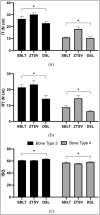The Influence of Implant Macro-geometry in Primary Stability in Low-Density Bone: An in vitro Study
- PMID: 40433430
- PMCID: PMC12105814
- DOI: 10.4103/jispcd.jispcd_155_24
The Influence of Implant Macro-geometry in Primary Stability in Low-Density Bone: An in vitro Study
Abstract
Aim: This study assessed the primary stability of implants featuring various geometries in polyurethane bone blocks simulating low-density bone types 3 and 4.
Methods: The study included 36 implants divided into three groups (Straumann BLT, n = 12; Zimmer TSV, n = 12; and Dentium Superline [DSL], n = 12). Implants featuring three different thread designs, a tapered body, a diameter of 4.0-4.1 mm, and a length of 10 mm were inserted into polyurethane bone blocks (20 and 15 PCF) to simulate bone types 3 and 4. Primary stability was evaluated using implant stability quotient (ISQ), insertion torque (IT), and removal torque (RT). IT and RT were compared using ANOVA, while ISQ was analyzed using the Kruskal-Wallis test. A P value < 0.05 was considered statistically significant.
Results: For bone type 3, the highest IT (30.21 ± 1.38 N cm) and RT (23.25 ± 2.30 N cm) value were observed for the Zimmer TSV, and the highest ISQ values (63.29 ± 0.54 N cm) were observed for DSL. For bone type 4, the highest IT (18.07 ± 1,71 Ncm) and RT (14.48 ± 1.81 Ncm) values were observed for the Zimmer TSV, and the highest ISQ values (58.46 ± 0.78 N cm) were observed for the DSL. The ISQ, IT, and RT values of the implant groups were significantly different (P < 0.001).
Conclusions: Implant geometry and bone density were key factors influencing primary stability in this study. The outcomes of the present study may help clinicians make decisions, especially when dealing with bone that has a less favorable quality. These findings may have important clinical implications related to immediate or early loading protocols, highlighting the critical role of implant design in attaining sufficient stability.
Keywords: Bone density; dental implant design; osseointegration; resonance frequency analysis (RFA).
Copyright: © 2025 Journal of International Society of Preventive and Community Dentistry.
Conflict of interest statement
There are no conflicts of interest.
Figures
Similar articles
-
The effect of implant design and bone quality on insertion torque, resonance frequency analysis, and insertion energy during implant placement in low or low- to medium-density bone.Int J Prosthodont. 2015 Jan-Feb;28(1):40-7. doi: 10.11607/ijp.4063. Int J Prosthodont. 2015. PMID: 25588172
-
Comparative investigation of primary stability of four different dental implants in low-density bone model.Dent Res J (Isfahan). 2019 Jan-Feb;16(1):18-23. Dent Res J (Isfahan). 2019. PMID: 30745914 Free PMC article.
-
Primary Stability Optimization by Using Fixtures with Different Thread Depth According To Bone Density: A Clinical Prospective Study on Early Loaded Implants.Materials (Basel). 2019 Jul 27;12(15):2398. doi: 10.3390/ma12152398. Materials (Basel). 2019. PMID: 31357620 Free PMC article.
-
The Influence of the Degree of Dental Implant Insertion Compression on Primary Stability Measured by Resonance Frequency and Progressive Insertion Torque: In Vitro Study.Biomedicines. 2024 Dec 18;12(12):2878. doi: 10.3390/biomedicines12122878. Biomedicines. 2024. PMID: 39767784 Free PMC article.
-
The influence of truncated-conical implant length on primary stability in maxillary and mandibular regions: an in vitro study using polyurethane blocks.Clin Oral Investig. 2023 Dec 26;28(1):28. doi: 10.1007/s00784-023-05444-x. Clin Oral Investig. 2023. PMID: 38147179
References
-
- Tumedei M, Piattelli A, Falco A, De Angelis F, Lorusso F, Di Carmine M, et al. An in vitro evaluation on polyurethane foam sheets of the insertion torque, removal torque values, and resonance frequency analysis (RFA) of a self-tapping threads and round apex implant. Cell Polym. 2021;40:20–30.
-
- Heitzer M, Kniha K, Katz MS, Winnand P, Peters F, Möhlhenrich SC, et al. The primary stability of two dental implant systems in low-density bone. Int J Oral Maxillofac Surg. 2022;51:1093–100. - PubMed
LinkOut - more resources
Full Text Sources



